Do-it-yourself washbasin for a summer residence: a review of the best designs and examples of homemade products
Do you like to spend time outside the city, but don’t want to give up the benefits of civilization? Agree that a comfortable holiday in nature is a hundred times more pleasant than the “wild” one. Have you decided to surround yourself with basic amenities and want to build a washbasin for your summer house with your own hands? However, don't know where to start?
We will help you figure it out - the article discusses the main options for washstands and the step-by-step stages of their construction, arrangement and connection to communications. The material is accompanied by detailed instructions, step-by-step photos and video recommendations for constructing a washbasin.
The content of the article:
Types of country washbasins
There can be many design options for organizing a washing area - it all depends on the size of the country estate/dacha, existing communications and the purpose of this plumbing fixture.
So, if the dacha is very small and there is not even a house as such, then it is quite possible to get by with a modest and simple option - a mounted mini-cistern. Which, by the way, you can make yourself or buy a ready-made container at a hardware store at a more than affordable price.
If you need to not only rinse your hands and freshen your face, but also wash dishes after household members, then it is advisable to consider the option heated washbasin – to make it easier and more convenient to wash greasy plates after pilaf or barbecue
If you have a fully equipped estate and you dream of making your own washbasin, which will be located in the open air, no less impressive, then you will have to show your imagination and set aside a day or two of free time.
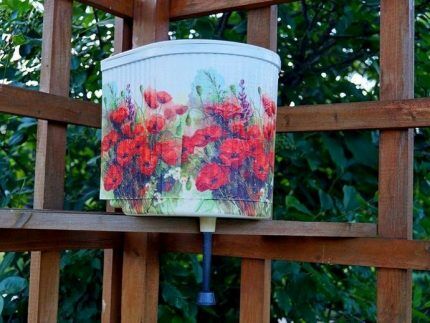
According to their purpose, washbasins in the country can be divided into the following categories:
- for washing hands and face;
- for washing fruits/vegetables outdoors;
- for dish washing;
- for all of the above + a separate stylish addition to the interior.
If the purpose of a country washbasin is to quickly wash your hands and face, but there is absolutely no time, then a simple washbasin with a rod would be appropriate.
It is also easy to make from scrap materials. True, his appearance is completely unpresentable.
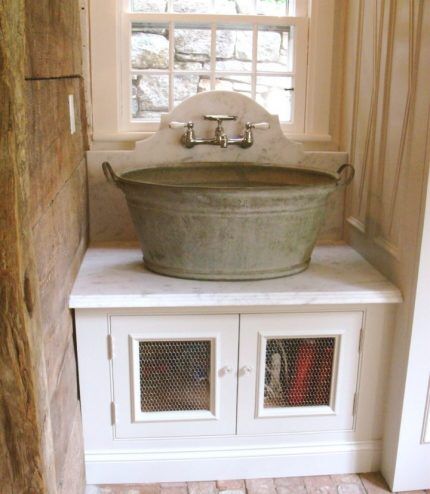
If you need a washbasin not only for quickly rinsing your hands after gardening, but also for washing dishes, then it is advisable to provide hot water.
The latter will be provided by a heating heating element, which will promptly heat up the entire tank of water and supply it in the required volume.
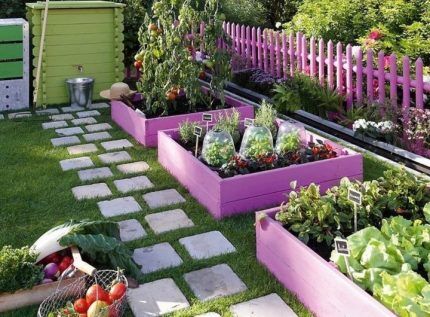
If you approach the issue of creating a washbasin creatively, use your imagination, starting from the decorative features of your dacha, then you can create something original and unique.
Below are non-standard solutions to the problem of making a country washbasin. Which can be not only useful, but also incredibly stylish.
It is also worth immediately considering the mode of drainage - into a nearby ditch, directly under your feet, or into a sewer pipe. The latter option is possible if there are amenities at the dacha.
If we are talking about a drainage “directly under your feet,” then it would not be amiss to pour crushed stone so that small splashes do not fall on your shoes and feet.
He will introduce you to ten market-leading options for country washbasins next article, in which design options are analyzed and technical characteristics are given.
Detailed manufacturing instructions
The location and purpose of the washbasin largely determines its appearance. It is also important to have the skills to assemble various useful homemade products for the home, the availability of free time, available materials, tools, and available means to implement your idea.
Let's look at the simplest ways to make a washbasin yourself, which require virtually no investment.
Option #1 - the simplest homemade washbasin
Most often, for a summer house you need to assemble something simple and do it quickly. And so that the finished product copes with its tasks perfectly. In such situations, a purchased washbasin design is used - a container with a volume of 3-4.5 liters, where a dosed supply of water is realized through a rod. You have to press it to wash your hands.
Such a device costs about 130 rubles if we are talking about plastic and from 600 rubles when the container is made of metal. The latter option is preferable because it will last longer. But this seemingly banal water container has its advantages.Let's look further at the main ones in the gallery.
Despite the low cost and a number of advantages, summer residents do not always buy a cheap washbasin with a rod. Everyone has their own reasons: some people don’t like its appearance, others think its capacity is insufficient, and its design is too flimsy. But not everyone will decide to buy a good-quality metal copy for 1200-1500 rubles for their dacha - after all, it can simply be stolen by “unscrupulous” people while the owners are away.
Moreover, sometimes you can accidentally be left without a washbasin - something heavy and sharp has been dropped, or an old plastic washbasin has accidentally fallen and the body has burst.Shouldn’t we be left in such a situation without a washstand? Therefore, the optimal solution would be to assemble the washbasin yourself using available materials. For example, you can use a plastic bottle as a base.
Let's look at step-by-step instructions for making such a homemade product.
If you figure out how to make a simple plastic washbasin, then such a homemade product will not cost you a single ruble, because you will definitely find a syringe in the first aid kit. And the product will serve for more than one day.
Moreover, if plastic no longer suits you, you can make a new container at any time - fortunately there is no shortage of plastic containers.
Option #2 - washbasin without tank
This type of washbasin can be made in a matter of minutes, especially if you have plastic left over after renovation. The tap and tank are not needed here - you can use them instead watering hose with a pistol, equipped with several spray modes.
You will also need the following materials for homemade work:
- scraps of plastic or polypropylene pipe;
- screwdriver and small screws;
- ready-made sink bowl or homemade one;
- corrugation with a siphon for draining wastewater into the nearest ditch;
- thick wire or other device from which you can bend an improvised stand for attaching a watering gun to the sink.
Making a simple homemade sink from a plastic or metal salad bowl will take up to 10 minutes. You will need to make a hole that will be equal to the diameter of the siphon, then install a real siphon with corrugation in it, as in a regular sink, tightening the fasteners tightly.
Now let’s start assembling the “makeshift” washbasin.
This type of sink can be assembled quickly, but it performs its task properly - you can immediately wash the collected vegetables or fruits, or wash your hands after transplanting plants/flowers, etc. And she is not afraid of rain.
Option #3 - washbasin made from a canister
A more capital design is a washbasin with a tap. It can be assembled from scrap materials, provided that you have tools, a canister and a tap.It is better to take a metal one - it is more reliable and will last much longer. But plastic is much cheaper.
You can also use any clean metal container – a bucket, small barrel, etc. – for the tank. It is important that no hazardous liquids, toxic chemicals or other compounds harmful to human health and life are poured into it.
We will consider the procedure for making a washbasin below:
Once the squeegee is installed, the job is up to the tap. Its installation is not difficult - the pipe with external thread easily connects to the coupling installed before.
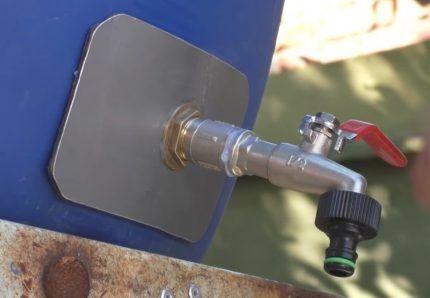
Having completed the manufacture of the tank, all that remains is to place it in the right place - by placing it on a stand, hanging it on the wall or in another way.
There are a lot of mounting options - you can choose the most suitable one for a particular situation.
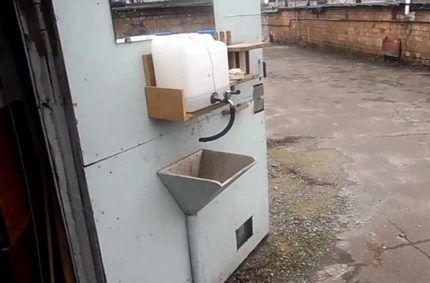
By analogy with a plastic canister, you can build a washbasin from metal - from an old saucepan, kettle, ladle, bucket or other utensils. And if you also paint and decorate it, the resulting washstand will be simply delightful.
Conclusions and useful video on the topic
Making a homemade washbasin from plastic in the following video:
Simple and quick assembly of a washbasin for temporary use:
Option for a spacious washbasin made from a canister:
If you arrive at your dacha on a holiday and there is no washbasin at hand, there is no need to be sad. You can build a device for carrying out hygienic procedures with your own hands, using available materials.
Moreover, it can be a simple plastic bottle or a banal canister - as a result of simple manipulations you will get a working washbasin.
Would you like to tell us how you made an original washbasin for your dacha with your own hands? Do you have information on the topic of the article that might be useful to site visitors? Please write comments in the block below, ask questions, post photos.




In fact, it’s not difficult to make a washbasin yourself from any available materials. Here the question is different: should the washbasin perform a decorative function or only a direct one? If decorative, then the flight of fancy can be prohibitive. If direct, then you need to proceed from practicality. For example, I started with the question of the “integrity” of my neighbors in the country. The answer is negative. This means that buying a washbasin or making one for the future is a waste of time. Exit? A simple plastic washbasin for 200 rubles in a hardware store. That's all.
I remember with nostalgia our childhood dacha with a washbasin in the form of an aluminum bucket with a rod that you pressed, and water heated by the sun poured out. The option with a plastic bottle is also well known to everyone.
Now I have a large plastic tank with a faucet built into it. It is suspended at a slight angle for better pressure. The design is simple, it costs little, and it performs its functions properly.
Nowadays there is a large selection of washbasins in stores at various prices. Therefore, I completely agree with Andrey. I remember my youth. If I had to go into the forest alone, I always took the usual one and a half cups of water with me. It was enough to simply fix it on the tree with the neck down and slightly unscrew the lid. The result was a convenient washbasin that did not take up much space in the backpack.
Yes, there are a lot of things in stores now, but is there any point in paying when you can easily and simply make it yourself from scrap materials? The same analogue of a bottle hung upside down in Leroy Merlin costs about 150-200 rubles. However, it is not of the best quality.An analogue of a canister with a faucet from the text above costs 1,500 rubles. The only advantage of store-bought washbasins is that they look a little more civilized, although even here you can come up with something and make your homemade product beautiful.
In fact, assembling a good washbasin at the dacha with your own hands and from improvised means is a very real task for everyone. It all depends on several factors: what exactly you have at hand and how much time you are willing to spend on this undertaking.
The simplest version from plastic bottles can be made by absolutely anyone, even a child can handle it. I suggest looking at slightly more practical options. For example, make a wooden frame that will accommodate a container for clean water with a tap and a reservoir for drainage. If you have old wooden barrels, you can use them to make a very beautiful and practical washbasin. Well, a very simple, but quite durable option: a plastic canister into which we cut a tap.
As a hint for those who want to make a washbasin with their own hands in the country. Once upon a time they came up with such a design and it ended up being very popular.
Here is an option with a well, that is, a water supply system, although initially the washbasin was intended to be “under a bucket”, they just drilled a well at the last moment. The design of the cabinet is a tabletop from a computer desk with a cut-out hole for a sink.
The walls of the cabinet are made of gypsum board on a frame (no, it won’t work and hasn’t worked in 4 years), lined with old Soviet 15x15 tiles. The taps are made of ordinary plastic shut-off valves.